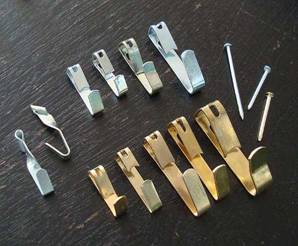 Photo 1
Photo 1
Standard wall hangers made of zinc and brass. Note the variance in hook angles. Twisted Moore Hanger with set nail angle (far left).
Selecting the correct wall hanger for any framed art or mirror is just as important as the wire and frame hardware. When choosing wire, it was stated in the February column "Which Wire" that the break strength of the wire should be three times (3x) that of the weight of the framed painting. When selecting wall hangers that is even higher with the support weight needing being four times (4x) that of the art. So a 10 lb hanger will only actually support a 2-½ lb painting. Two 10 lb hangers increase the weight tolerance to 5 lbs. In turn it takes two 50 lb hangers, equaling 100 lbs total weight tolerance, for a 25 lb painting.
Picture wire should always be hung onto two horizontal wall hanger set approximately at ⅓ and ⅔ intervals across the width of the frame, box or canvas. This is true even for a small 1# piece frame as two hangers balances the frame to better maintain the alignment and prevent shifting from closing doors, and holds the frame flatter to the wall with less forward tilt. Two hangers—properly set apart—also helps maintain the correct 60 degree angle of the wire for lest stress on the side legs of the frame.
Standard Hook Style
There are numerous sizes and shapes of standard frame hangers with front hooks that vary from 30 degrees to nearly 60 degrees. A soft "S" curve hook helps when hanging but might not be as secure as a steeper hook (photo 1). The style of a wall hanger is also very important and plays a significant part in the hanging of framed art. Standard zinc and brass courtesy or goodwill hangers are strong and economical, but lack the precision of a high quality professional hanger. The nails are thicker and a longer nail slot in the hanger allows the nail to move not maintaining a common angle during installation.
 Photo 1
Photo 1
Standard wall hangers made of zinc and brass. Note the variance in hook angles. Twisted Moore Hanger with set nail angle (far left).
For maximum strength the nail should be held to 30° penetration into the wall as found with the twisted design of Moore picture hangers or Ziabicki Floreat. The Moore twist holds the nail at the constant angle and the nail is longer and thicker than Ziabicki but are not tempered steel.
Standard hangers may be easily pulled from the wall when a painting is moved which can damage and enlarge the hold in the wall and/or allow the hook to fall out altogether. This makes the entire hanger weak and less secure. Also the flatter the angle of penetration into the wall the weaker the hold regardless of the hanger poundage tolerance (photo 2). Notice the extreme variance in the nail slant of all these standard hooks. The elongated nail slots allow inconsistency when installing these type of hooks. There is a huge nail angle variation so installation could be far less secure if installed at a flatter nail angle, in fact if too flat the hook could pull from the wall.
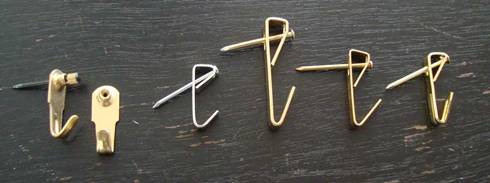 Photo 2
Photo 2
Note the flexibility of the insertion angle of the set nail. Even the floreat replica far left is not at 30°.
Floreat Style
Ziabicki Deluxe Floreat Hangers are the original German made picture hooks which remain the preferred brand of hangers among professionals in the custom framing industry (photo 3). They have thin tempered steel nails and solid brass knurled heads designed to be thin, strong and have nail guides that control entry of the nail into the wall at an optimum 30° angle, and there is a small Z trademark stamped on all authentic Ziabicki products. They are made in assorted sizes to hold 10, 20, 30, 50, and 75 pounds and are available online or through assorted framing suppliers.
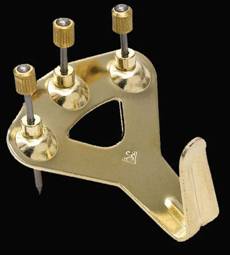 Photo 3
Photo 3
Ziabicki Floreat hangers are all stamped with their trademark.
For heavy or oversize art two strap hangers mounted vertically to the frame and two Floreat hangers of proper strength should suffice for drywall installations. For cement or brick walls the nail holes will require predrilling prior to installation. Floreat hangers do not work well for heavy art on plaster walls as the wall can crumble over time.
The basic Ziabicki design has been emulated by many including Moore, OOK, and numerous private labels (photo 4).
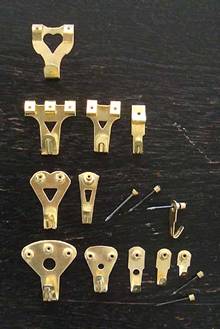 Photo 4
Photo 4
Floreat-style hangers: unknown copy (top); Moore version of Ziabicki Le Crochet; OOK 50# and 30#; private label versions (bottom).
The most commonly seen floreat replica is OOK Professional Picture Hanger which claims to distribute the weight of the picture evenly to support heavy paintings while not damaging walls. Their nail inserts into wall at a similar angle as the Floreat, are secure, reusable, and work well for plaster or sheetrock. They are less expensive and widely available at home improvement, hardware, craft and grocery stores.
Floreat Security Hangers
Ziabicki also offers a light security hanger that comes with a slip clamp that will prevent hung art from being easily removed once hung (photo 5). They are perfect for securing art in earthquakes to prevent it from involuntarily crashing to the floor, but may not deter the entire hanger from being ripped from the wall in case of attempted theft. Available in 30 lb and 75 lb sizes these should also be installed two per frame for stability weight distribution and balance.
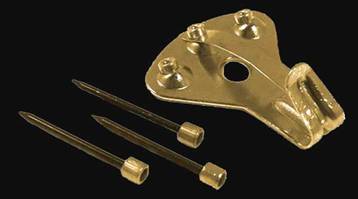 Photo 5
Photo 5
Ziabicki Security Hangers have a spring clip to ensure art does not slip from hanger.
French Cleat Hangers
Standard and floreat hangers are not the only hardware available for wall installation, though they are most common. Referred to as French Cleat Hangers—heavy duty panel hangers, Z Clips, panel clips, wall cleat, hanging cleat, or cleats—these strips are frequently selected to install any large object that needs support across its full length. They provide a simple and secure method for hanging panels, cradled boxes, and other large art on flat wall surfaces and may be made of wood or purchased commercially in metal pairs. One length of the cleat is installed on the wall and another length is flipped upside down and fastened to the art panel or canvas. Because the weight of the object is dispersed along the entire length of the hardware, heavier objects may be mounted efficiently and securely with cleat hangers rather than D-straps hung at only two weight points.
Wood Cleats
The traditional French Cleat is used in carpentry, where interlocking wood wedges are employed to hold an object—often cabinets—in place (diagram 1). These may be made to fit whatever panel size. Inspect all wood to be sure there are no cracks, splits or other damage that could weaken the cleat. Cut one piece so it fits snugly against the top panel and both sides. The wall-mounted piece should be ½" to 1" narrower to make hanging the panel easier. Rip both pieces at 45-degrees then sand 1/16 to ⅛" from the sharp point on both pieces.
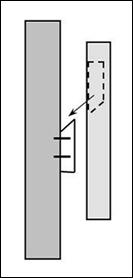 Diagram 1: Wood Cleat
Diagram 1: Wood Cleat
Top bar is mounted inside box with bevel cut bottom. Mount piece is narrow enough to fit inside the box is mounted to the wall.
Metal Cleats
Commercial interlocking extruded aluminum cleats (diagram 2) are 1-⅛" wide by 3/64" thick and come light-duty, medium-duty and heavy-duty, to provide a simple, strong and reliable installation for any flat object on a wall (photo 6). The medium and heavy-duty versions are capable of supporting very heavy items that no other small hanging method can handle. Light-duty cleats support up to 30-35 lbs, medium up to 75-80 lbs and heavy duty support over 80 lbs. Light-duty cleats are available in assorted in lengths with 6" long for pictures up to 20" wide, 12" long for pictures 20" to 30" wide, and 18" long for pictures over 30" wide.
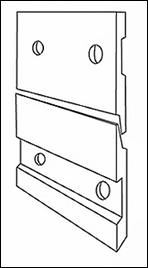 Diagram 2: Commercial Cleat
Diagram 2: Commercial Cleat
Light-duty metal cleats holes pre-drilled ever 4-6".
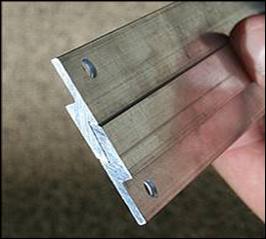 Photo 6
Photo 6
Light-duty extruded aluminum. Bottom attaches to the wall, top attaches to the frame.
www.hooksandlattice.com
Cleats are secure alternatives to wire for heavy or hard to install wire and are available in a variety of styles from numerous industry sources. To use cleat hangers the bottom cleat strip is securely attached to the wall with screws while the matching cleat must be attached to the inside edge of the back side of the frame's top rail. It is very important that cleats be mounted as level as possible. Only slight leveling adjustments can be made after installation. The Z Hanger—also known as a Z Bar or Zbar—is a simple, two bracket assembly that locks together and can hold up to 400 lbs. One bracket is secured on the wall while the other bracket is secured on the object to be hung (photo 7). The EZ Bar System is also extruded aluminum designed to hang art, mirrors, cabinets and heavy objects weighing 40 pounds to 90 pounds available from AMS. The Hangman Products Z Hangers support up to 400 pounds as professional French cleats for heavy mirrors, pictures and home wall décor.
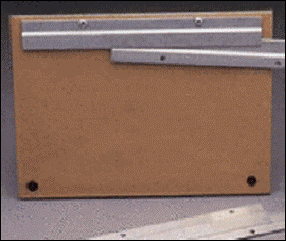 Photo 7
Photo 7
Z Bar Hanger
www.123frame.net
Basic Installation:
The Final Step
Though it is up to the framer to determine the hardware system required to properly display any art, wall hangers should never be overlooked in the custom framing process. It is great customer service to supply two Goodwill standard wall hangers with every framed item, but perhaps a little additional education on using both of them is highly suggested as well as why not to hang on a nail might also be of benefit. Plus a selection of alternative better or best hangers might also help prove your expertise.
END
Copyright © 2013 Chris A Paschke
Resources—Items
http://ziabicki.com—Ziabicki Floreat Hangers, Floreat Security Hangers
http://123frame.net (Carina Picture Frame)—Z Bar, Z Hangers
http://govart.com (Picture Hanging Solutions)—Aluminum Cleat Bars
http://artmaterialsservice.com—E Z Bar System
http://hangmanstore.com (Hangman Store)—Professional French Cleat, Z Hangers, Mirror & Picture Hangers
For more articles on mounting basics look under the mounting section in Articles by Subject.
Additional information on all types of mounting is found in:
The Mounting and Laminating Handbook, Second Edition, 2002,
The Mounting And Laminating Handbook, Third Edition, 2008 and
Creative Mounting, Wrapping, And Laminating, 2000 will teach you everything you need to know about getting the most from your dry mount equipment and materials as an innovative frame designer.
All books are available from Designs Ink Publishing through this website.
Chris A Paschke, CPF GCF
Designs Ink
Designs Ink Publishing
785 Tucker Road, Suite G-183
Tehachapi, CA 93561
P 661-821-2188
chris@designsinkart.com